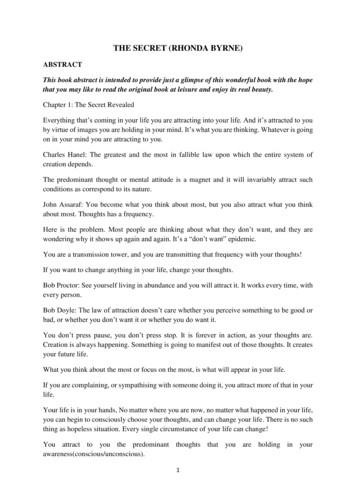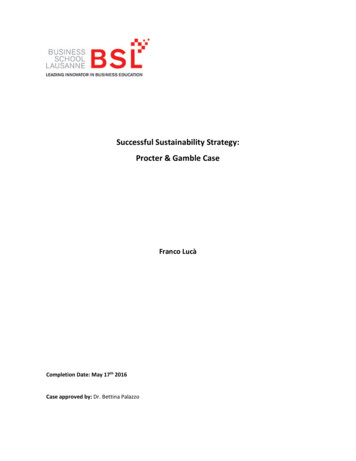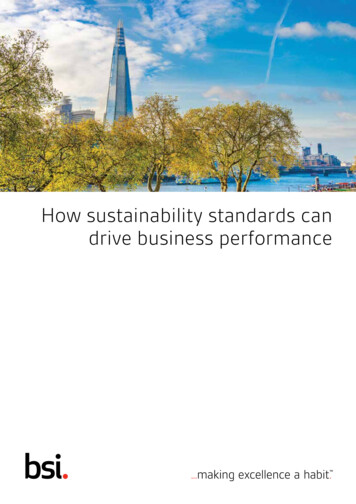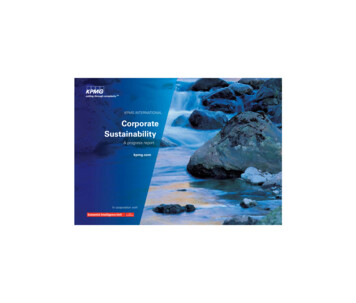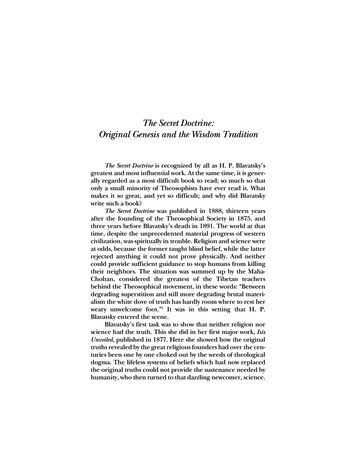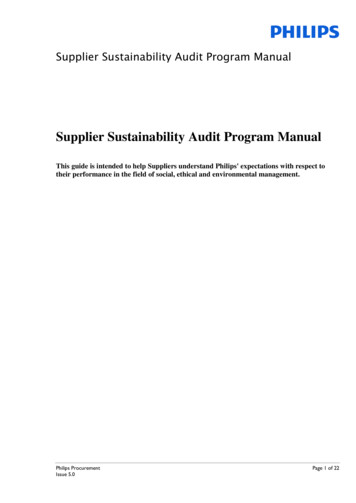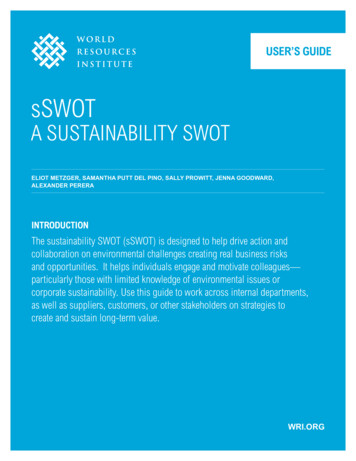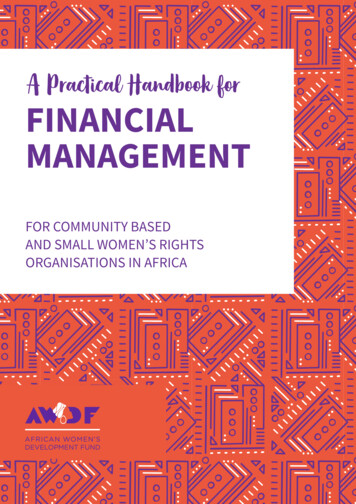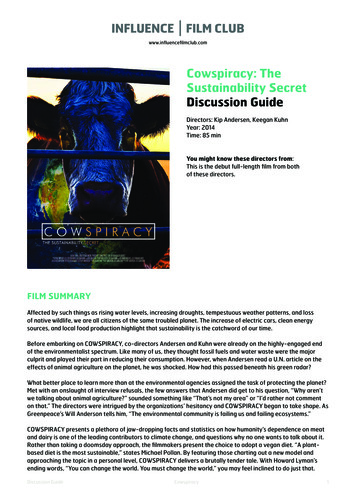
Transcription
www.influencefilmclub.comCowspiracy: TheSustainability SecretDiscussion GuideDirectors: Kip Andersen, Keegan KuhnYear: 2014Time: 85 minYou might know these directors from:This is the debut full-length film from bothof these directors.FILM SUMMARYAffected by such things as rising water levels, increasing droughts, tempestuous weather patterns, and lossof native wildlife, we are all citizens of the same troubled planet. The increase of electric cars, clean energysources, and local food production highlight that sustainability is the catchword of our time.Before embarking on COWSPIRACY, co-directors Andersen and Kuhn were already on the highly-engaged endof the environmentalist spectrum. Like many of us, they thought fossil fuels and water waste were the majorculprit and played their part in reducing their consumption. However, when Andersen read a U.N. article on theeffects of animal agriculture on the planet, he was shocked. How had this passed beneath his green radar?What better place to learn more than at the environmental agencies assigned the task of protecting the planet?Met with an onslaught of interview refusals, the few answers that Andersen did get to his question, “Why aren’twe talking about animal agriculture?” sounded something like “That’s not my area” or “I’d rather not commenton that.” The directors were intrigued by the organizations’ hesitancy and COWSPIRACY began to take shape. AsGreenpeace’s Will Anderson tells him, “The environmental community is failing us and failing ecosystems.”COWSPIRACY presents a plethora of jaw-dropping facts and statistics on how humanity’s dependence on meatand dairy is one of the leading contributors to climate change, and questions why no one wants to talk about it.Rather than taking a doomsday approach, the filmmakers present the choice to adopt a vegan diet. “A plantbased diet is the most sustainable,” states Michael Pollan. By featuring those charting out a new model andapproaching the topic in a personal level, COWSPIRACY delivers a brutally tender tale. With Howard Lyman’sending words, “You can change the world. You must change the world,” you may feel inclined to do just that.Discussion GuideCowspiracy1
www.influencefilmclub.comFILM THEMESWhen Kip Andersen learns that animal agriculture and humanconsumption of meat and dairy is one of the leading contributors toclimate change, he uncovers an issue with immense ramifications.THE SUSTAINABILITY SECRET“Raising and killing animals for food is really what’s killing the planet,”announces Demosthenes Maratos of The Sustainability Institute. Thisbold declaration serves as the backbone for COWSPIRACY, somethingco-directors Andersen and Kuhn are determined to uncover andunderstand. With society handed a long list of factors affecting climatechange and encouraged to make multiple changes to behavior andhabit, it seems extraordinary that one of leading contributors to globalwarming and planetary destruction hasn’t made the cut.MONEY WIELDS ITS MAGIC WANDWho hit the mute button on discussing the connection between animalagriculture and climate change? Arguably, money has the power todrive corruption and inspire skewed decision making. “If you causea disruption in the profits of the animal industry, you’re guilty underthe Patriot Act,” states former rancher Howard Lyman. As the mostfinancially fruitful powerhouses in the U.S., the meat and dairy industrieswield incredible might over political agendas. As for the promise of NGOsto protect the planet’s ecosystem and people, their agendas also seemto be influenced by the power of these lucrative industries.THE FEARThe more Andersen learns about the detrimental impact of animalagriculture on the planet’s water, rainforests, air quality, oceans, andoverall health, he wonders why no one is broaching the subject. Manydirectors at the NGOs he interviews deny his accusations. Then he iswarned, those who do agree speak of threats, imprisonment, even death.A fear is apparent in each individual who dares to address his concerns.The governmental machine is powerful, and with laws in place to protectthe steady flow of profitability for those feeding the greed, it is acourageous move that the filmmakers continue with their feature.THE SUSTAINABLE ANSWER? VEGANISMOnce the facts and figures have been presented, the arguments drawn,and the case is presented that animal agriculture is the leading cause ofan unsustainable existence, both for people and planet, only one optionremains–veganism. In the words of Howard Lyman, “You can’t be anenvironmentalist and eat animal products. Period.” Have we come thatfar? Where the call for such a profound change in behavior across theboard is so strong that humanity faces up to our lifestyles and adapts adifferent way of life altogether? “No other lifestyle choice has a fartherreaching and more profoundly positive impact on the planet and all lifeon earth than choosing to stop consuming animals and live a vegan life,”purports Demosthenes Maratos. If veganism could steer our planet in asustainable and healthy direction, perhaps more of us will adopt a plantbased diet.Discussion GuideCowspiracy“It’s anenvironmentaldisaster that’sbeing ignored bythe very peoplewho should bechampioningdeforestation,land use, waterscarcity, thedestabilizationof communities,world hunger.”Demosthenes Maratos“A lot of peoplekeep theirmouths shut.They don’t wantto be the nextone with thebullet to theirhead.”Leila Salazar-López, Amazon Watch2
www.influencefilmclub.comFURTHER DISCUSSIONS:1.NOTES:What had you heard about COWSPIRACY before watching the film?Did it live up to any expectations you brought into the viewing?Are there any ways in which you were disappointed or pleasantlysurprised by the film?2. How would you describe your eating habits? How much meat anddairy do you consume on a daily basis? Do you consider yourself tobe healthy?3.Discuss your thoughts on vegetarianism and veganism? Are you/have you ever been a vegan/vegetarian? Is it possible to live ahealthy, well-balanced life without consuming any animal products?4. Were you convinced by the directors’ argument that animalagriculture is the leading cause of climate change? Had you beenintroduced to this concept before watching the film? What have youbeen taught to believe are some of the leading factors of climatechange and global warming?5. What is your definition of an environmentalist? Do you consideryourself to lead a green life? Do you live in a community whereearth-friendly initiatives are widely practiced?6. Do you support any of the organizations interviewed and/ormentioned in the film, such as Greenpeace, Sierra Club, RainforestAction Network, and Surfrider Foundation? Were your views of nongovernmental organizations affected by the film?7. What is your definition of sustainability? What does living asustainable life entail? Does this include ensuring conditions are alsosustainable for the natural environment and wildlife?8. Do you believe we still have the opportunity to “save the planet,”or have we gone too far? Do individual lifestyle changes have thepotential to impact the world in a meaningful way?9. What steps can be taken in order to ensure that animal agricultureis addressed openly and honestly by environmental agencies andour governments? How can we as individual citizens encouragepolicymakers and changemakers to tackle the problems inherent inanimal agriculture and overfishing?10. Do you believe society as a whole can be convinced to adopt avegan diet, or a diet less reliant on meat and dairy? Or are people’sbehaviors too deeply ingrained?Discussion GuideCowspiracy3
www.influencefilmclub.comFILM FACTS: COWSPIRACY had its world premiere at the SanFrancisco Green Film Festival in 2014. A new cutof the film, which was executive-produced byLeonardo DiCaprio, premiered globally on Netflixin September 2015. The directors funded film production throughIndieGoGo, reaching their initial goal of 54,000in six days. In the end all donations came fromindividuals—no companies supported the filmfinancially, and those that chose to retract theirinitial funding did so due to the fact that theysupported organizations interviewed in the film.A total of 117,092 was raised, which enabledthe film to be subtitled in Spanish, German,French, Dutch, Polish, Italian, Norwegian,Swedish, Russian, Arabic, Mandarin, Japanese,Portuguese, Hindi, Bulgarian, Lithuanian, Slovak,Estonian, Czech, Turkish, and Hebrew. The directors originally set out to interviewNGOs on animal agriculture, which preventedthem from securing interviews. When theyinstead mentioned they were making a film onsustainability, NGOs were more open to meet. Andersen screened COWSPIRACY to theEuropean Parliament in Brussels in December2015. So affected by the film, two parliamentmembers purchased 750 copies of the DVD asholiday gifts for each and every parliamentarian. The first animal-free cookbook was published inLondon, England, in 1849. The Animal Enterprise Terrorism Act, signed intolaw by President Bush in 2006 as an amendmentto 1992’s Animal Enterprise Protection Act,grants the U.S. Department of Justice greaterrights in silencing the protest activities of animaland environmental advocates. Howard Lyman, the Montana cattle farmerturned animal rights activist, has been vegansince 1991. The growth of a tumor on his spinalcord in 1979 forced him to take a closer look athis life, which inspired his assessments of theU.S. food industry. When he appeared on TheOprah Winfrey Show in 1996 and convinced herto stop eating hamburgers, he was sued by theNational Cattlemen’s Beef Association. The term vegan, which represents a lifestyledevoid of animal exploitation, was coined in 1944by Donald Watson, the founder of the VeganSociety of England, the world’s oldest veganorganization. Notable vegans include StevieWonder, Demi Moore, Carl Lewis, and Al Gore. According to the U.N.’s Food and AgricultureOrganization, 38% of the world’s land is used foragriculture, poultry birds account for 80% of alllivestock, and the total world water withdrawalfor agriculture is 95%. Many more facts can befound on the COWSPIRACY infographic. In 1965 the average American ate 166 pounds ofmeat and poultry annually. That number was upto 224 pounds in 2004, and down to 211 in 2015.WAYS TO INFLUENCE1.Take the 30-Day Vegan Challenge as provided on the film’s website, with informative podcasts and engagingvideos to encourage you along.2. Learn more about director Andersen’s Animals United Movement, a media organization setting out “toeffectively and efficiently represent a harmonious voice for all life on this planet.”3.Read “MEATHOOKED: The History and Science of Our 2.5-Million-Years Obsession With Meat,” writtenby science author and travel writer Marta Zaraska examining the evolutionary, cultural, taste, marketing,biochemical, and anthropological reasons why humans are so hooked on meat.4. Challenge your own food perceptions by analyzing how much meat and/or dairy you eat in a single day.Discussion GuideCowspiracy4
www.influencefilmclub.comWe believe a good documentaryis just the beginning In a world of sound-bites, documentaries provide an opportunityto think, understand, share, and connect with the world.They are controversial, divisive, fascinating, unexpected, andsurprising. They can be thrillers, dramas, comedies, romance,tear-jerkers, and horror films.Documentaries provide the perfect topic for meaningfulconversations. If you want to talk about the things that matterwith people that matter then pick a film, invite your friends, andwatch & discuss together. It’s as easy as that.Influence Film Club – We are the conversation after the film.Influence Film Club is a not-for-profit dedicated to expanding audiencesfor documentary films.
Greenpeace’s Will Anderson tells him, “The environmental community is failing us and failing ecosystems.” COWSPIRACY presents a plethora of jaw-dropping facts and statistics on how humanity’s dependence on meat and dairy is one of the leading contributors to climate

